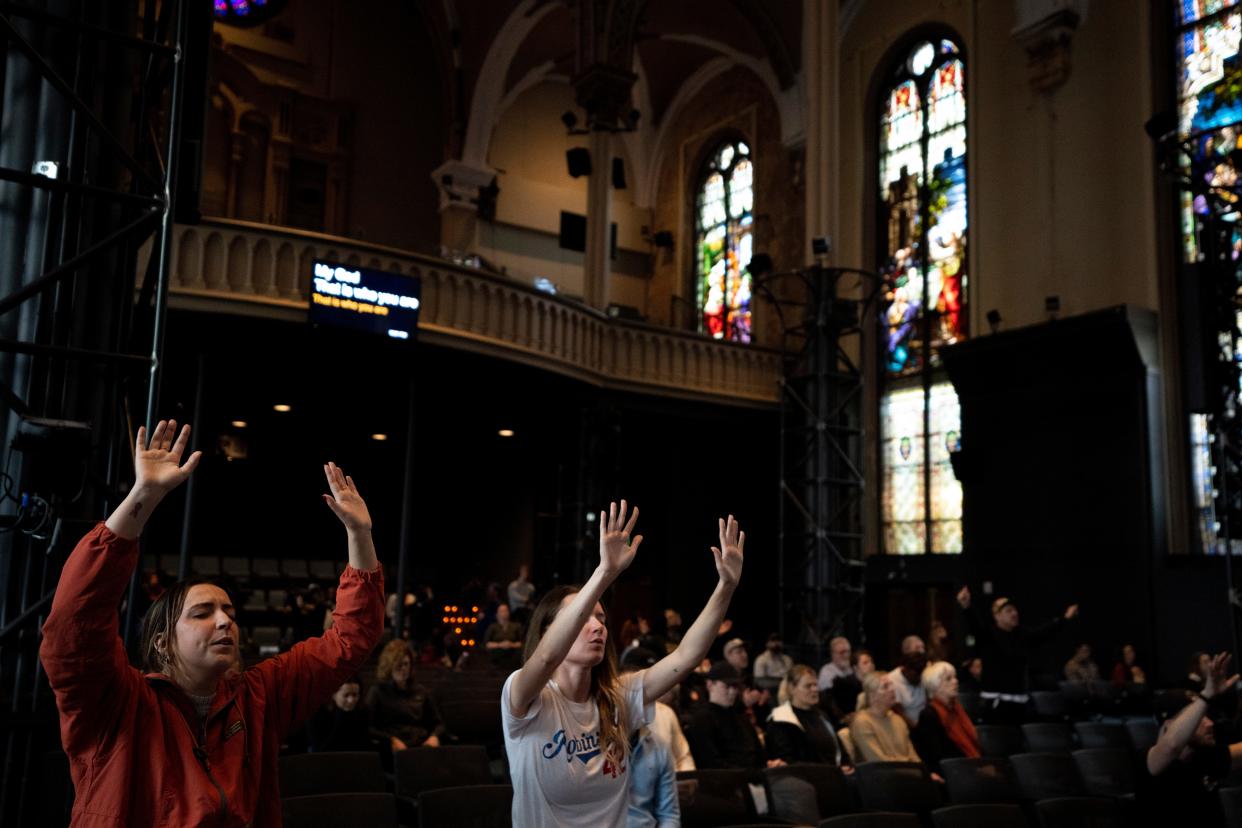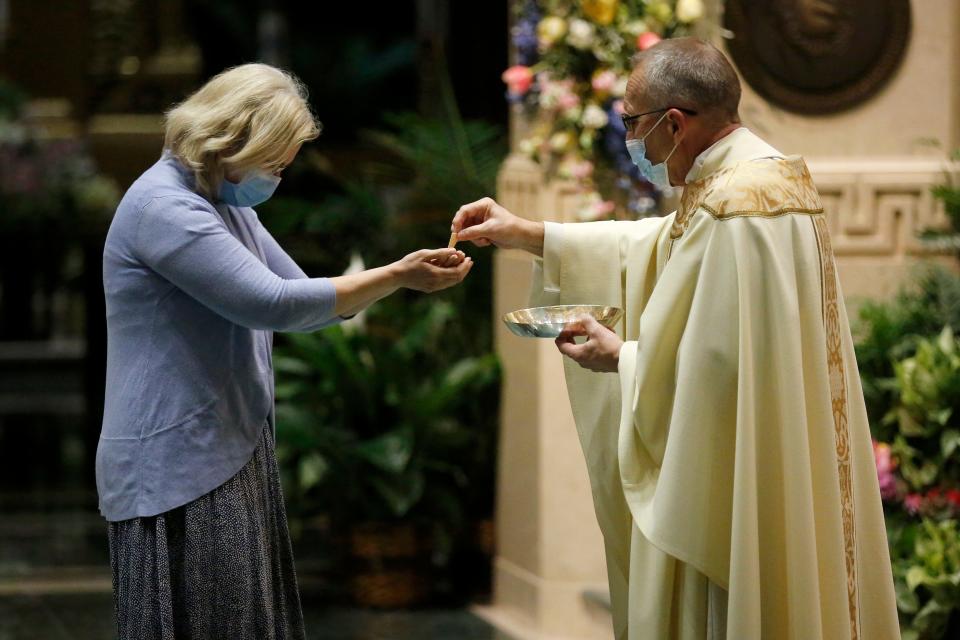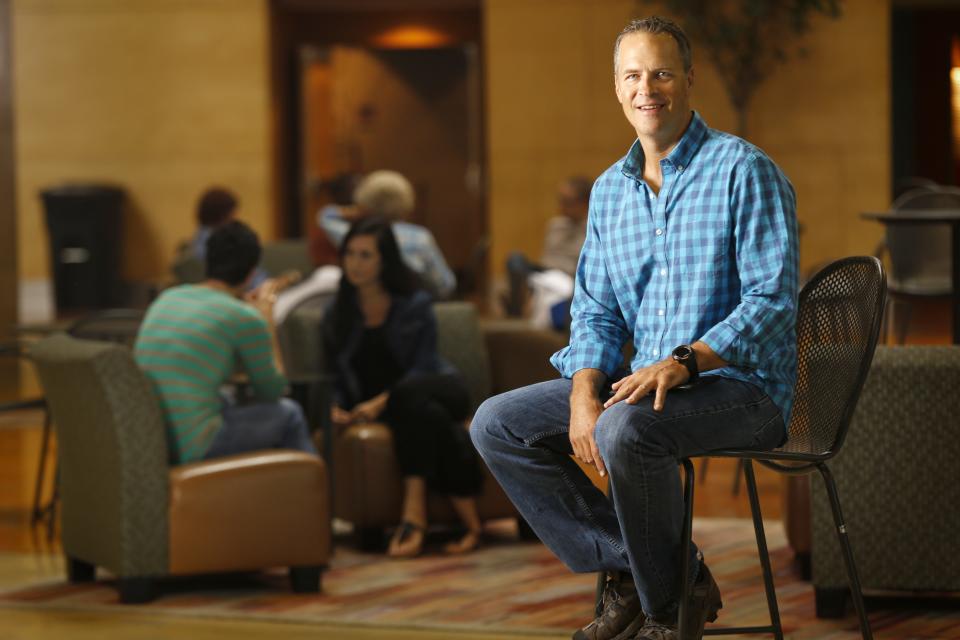Evangelicals now outnumber Catholics and mainline protestants in Greater Cincinnati

Sunday services during Lent look and sound pretty much the same today at Cincinnati’s St. Peter in Chains Cathedral Basilica as they did when the Downtown church first opened its bronze doors almost 180 years ago.
Worshipers then and now would recognize the stained glass and Greek mosaics, the Lenten hymns and prayers, and the Catholic priest in ceremonial vestments at the altar.
But for tens of thousands of Christians in Greater Cincinnati, including many former Catholics, Lent today is more likely to look as it does at Crossroads Church in Oakley, where drums and electric guitars provide a rock music soundtrack, short films deliver inspirational messages, and the pastor paces the stage in Nikes and jeans.
In just a few decades, the growth of nondenominational evangelical churches like Crossroads has transformed the region’s religious landscape, changing the way Christians celebrate their faith and engage with organized religion.
Evangelical protestants now make up a larger share of Greater Cincinnati’s population than Catholics and mainline protestants combined, according to the U.S. Religion Census.
That’s a dramatic shift in a place where Catholics alone once outnumbered evangelicals by almost 2 to 1, and where most protestants once favored Methodist, Presbyterian and other established denominations over evangelical churches.
Evangelical numbers jump in city as well as suburbs
While evangelicals always have been strong in suburban counties, such as Butler and Warren, they’ve more than tripled their share of the population in Hamilton County in the past two decades.
The Religion Census, a nationwide survey of religious groups that is not associated with the U.S. Census, found evangelicals now make up 25% of the population in Greater Cincinnati, up from less than 16% in 2010. Catholics now account for 17%, down from 19% in 2010.
Together, Catholics and mainline protestants today represent 21% of the region's population.
“We’re working on getting above that trend,” said the Rev. Jan Schmidt, director of pastoral vitality at the Archdiocese of Cincinnati. “It’s hard to do.”
It’s hard, at least in part, because Americans aren’t just moving away from traditional churches to new churches, as the Religion Census found they’re doing in Greater Cincinnati. In many places, they also are moving away from organized religion altogether.
Attendance at religious services has been falling for years among Americans of almost all faiths, a trend that accelerated during the COVID-19 pandemic.
A decade ago, 56% of Americans reported attending religious services at least a few times a year, according to the Public Religion Research Institute. In 2022, that number tumbled to 43%.
“We’ve seen big declines in church membership and church attendance after the pandemic,” said Melissa Deckman, the institute’s CEO. “Almost all the churches that I’ve read about have really been experiencing a decline in people attending and joining.
“And that’s part of a larger, broader pattern over the last couple of decades.”
A movement from old churches to new
There’s no single explanation for the pattern of decline.
Some mainline protestant churches splintered over gay marriage and other issues. Catholics continue to struggle with fallout from the clergy abuse scandal. And many religious people face challenges as debates over abortion, politics and the culture wars collide with the teachings of their faith.
Schmidt said growing divisions and distrust in institutions, including religious institutions, is part of the problem. But he said the drift away from religion also reflects the privilege and wealth that he believes has become ingrained in modern American society.
“It’s an unfortunate circumstance of – forgetting who really made us, who has given us everything that we have,” Schmidt said. “Now we seem to be so equipped to do it on our own. We don’t need God.”
For now, at least, Greater Cincinnati appears to be experiencing more movement of people between faiths than away from faith entirely.

The Religion Census, which couldn’t capture the full impact of the pandemic because it was conducted in 2020, revealed a sharp increase in nondenominational evangelical church attendance in the years leading up to the pandemic.
In 2010, the census found nondenominational evangelical churches in Greater Cincinnati claimed about 80,000 adherents. By 2020, that number had climbed to 360,000.
Crossroads makes big impact in Greater Cincinnati
Crossroads, with about 30,000 members, is a big reason why. Founded here two decades ago, the church now has eight locations from Columbus to Lexington, including an arena-style gathering place for services in Oakley.
Brian Tome, the founding and senior pastor at Crossroads, credited the church’s appeal to a come-as-you-are ethos that appeals to people who’ve never been closely tied to another faith and to former members of traditional churches who’ve become disillusioned with those institutions.
Raised in the Presbyterian Church and trained as a minister there, Tome counts himself among those who grew to feel out of place in the church of his childhood.
He said older, established churches are built on “duty and rules,” rather than on innovative approaches to nurturing the spiritual life of their people. Sometimes, he said, being innovative means putting a drum set on stage with the pastor, and sometimes it means dressing casually and preaching with a cup of coffee in hand.
The goal, Tome said, is to create a service that’s more relatable and, therefore, more effective. He said those who criticize the informality of Crossroads and other large nondenominational churches, sometimes known as mega churches, are missing the point.
“When you crack on mega churches, you’re cracking on millions and millions and millions of people who are saying with their feet and with their wallets that this helps me,” Tome said. “This is a form of spirituality that reaches them where they are.”

'We take God very seriously'
The difference between the new churches and the old is more than just style.
St. Peter in Chains and Crossroads are separated by about 8 miles of interstate highway but also by roughly 2,000 years of religious tradition.
Crossroads didn’t only change or abandon parts of the weekly service that’s practiced in Catholic and mainline protestant churches. Its pastors preach a different approach to spiritual life, one that’s plain to see this time of year, during the holiest days on the Christian calendar.
Instead of confessing sins to a priest and making personal sacrifices during Lent, Crossroads’ members are asked to privately consider what they want to change in their lives. A suggestion on Crossroads’ website urges the faithful to write on paper what they’d like to “turn away from,” pray about it, resolve to change and then destroy the paper.
The approach requires no priest, no holy sacrament, no one to intercede with God on the person’s behalf.
Marc Duebber, a Crossroads member, said the emphasis on a relationship with God outside of any religious institution is why he feels more connected to his faith now than when he attended protestant churches as a kid or Catholic services as a student at Elder High School.
“I don’t need to tell somebody something and have him tell the Lord for me when I can speak to Him myself,” Duebber said.
Sarah Anderson said she felt a similar connection when she and her husband began attending a nondenominational Vineyard Church almost 20 years ago. She quickly embraced a service that did away with the “pomp and circumstance” she’d known growing up in the Presbyterian Church.
“We take God very seriously, but we don’t take ourselves very seriously,” said Anderson, who’s now pastor of a Vineyard Church in Finneytown. “That kind of atmosphere was really appealing to us.”
Traditional churches try to reverse trend
But adherents to the older, traditional Christian churches say there’s a reason they do things the way they do. Catholicism is the first Christian faith, the “Mother Church,” as Catholics say, and its routines and teachings are rooted in traditions that date to the time of Christ.
Schmidt, the archdiocese's director of pastoral vitality, said abandoning that structure might seem appealing to some. But without it, he said, religion can become trendy or convenient, subject to the whims of the moment.
“We human beings have a natural inclination towards God,” Schmidt said. “When there’s no guidance toward that, you wind up looking for gods, or God, in all the wrong places.”
He said the big nondenominational churches can help people “find some sense of faith,” but he worries they also might leave people spiritually rudderless.
Schmidt said he’s particularly concerned about a growing number of young people with no religious affiliation. Known as the “cradle nones,” as opposed to lifelong “cradle Catholics” or “cradle Methodists,” they are raised in homes with no structured faith life.
To combat the trend, Schmidt said, Catholics need to do a better job educating their children and everyone else about the meaning behind the church’s traditions.
Schmidt called that work “missionary discipleship.” Evangelicals might call it evangelization.
Deckman, the CEO of the Public Religion Research Institute, said the trends suggest such work will be difficult, regardless of the faith. For years now, she said, people unaffiliated with any religion have been the fastest-growing segment of the population.
“Could there be a religious revival of some sort in the future? Sure, I guess,” Deckman said. “But I don’t think it’s necessarily likely.”
This article originally appeared on Cincinnati Enquirer: Evangelicals in Cincinnati now outnumber Catholics, others

